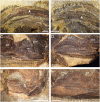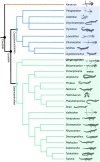A New Basal Salamandroid (Amphibia, Urodela) from the Late Jurassic of Qinglong, Hebei Province, China
- PMID: 27144770
- PMCID: PMC4856324
- DOI: 10.1371/journal.pone.0153834
A New Basal Salamandroid (Amphibia, Urodela) from the Late Jurassic of Qinglong, Hebei Province, China
Abstract
A new salamandroid salamander, Qinglongtriton gangouensis (gen. et sp. nov.), is named and described based on 46 fossil specimens of juveniles and adults collected from the Upper Jurassic (Oxfordian) Tiaojishan Formation cropping out in Hebei Province, China. The new salamander displays several ontogenetically and taxonomically significant features, most prominently the presence of a toothed palatine, toothed coronoid, and a unique pattern of the hyobranchium in adults. Comparative study of the new salamander with previously known fossil and extant salamandroids sheds new light on the early evolution of the Salamandroidea, the most species-diverse clade in the Urodela. Cladistic analysis places the new salamander as the sister taxon to Beiyanerpeton, and the two taxa together form the basalmost clade within the Salamandroidea. Along with recently reported Beiyanerpeton from the same geological formation in the neighboring Liaoning Province, the discovery of Qinglongtriton indicates that morphological disparity had been underway for the salamandroid clade by early Late Jurassic (Oxfordian) time.
Conflict of interest statement
Figures












Similar articles
-
Late Jurassic salamandroid from western Liaoning, China.Proc Natl Acad Sci U S A. 2012 Apr 10;109(15):5767-72. doi: 10.1073/pnas.1009828109. Epub 2012 Mar 12. Proc Natl Acad Sci U S A. 2012. PMID: 22411790 Free PMC article.
-
A Triassic stem-salamander from Kyrgyzstan and the origin of salamanders.Proc Natl Acad Sci U S A. 2020 May 26;117(21):11584-11588. doi: 10.1073/pnas.2001424117. Epub 2020 May 11. Proc Natl Acad Sci U S A. 2020. PMID: 32393623 Free PMC article.
-
Late Jurassic salamanders from northern China.Nature. 2001 Mar 29;410(6828):574-7. doi: 10.1038/35069051. Nature. 2001. PMID: 11279493
-
A new fossil from the Jurassic of Patagonia reveals the early basicranial evolution and the origins of Crocodyliformes.Biol Rev Camb Philos Soc. 2013 Nov;88(4):862-72. doi: 10.1111/brv.12030. Epub 2013 Feb 28. Biol Rev Camb Philos Soc. 2013. PMID: 23445256 Review.
-
High diversity, low disparity and small body size in plesiosaurs (Reptilia, Sauropterygia) from the Triassic-Jurassic boundary.PLoS One. 2012;7(3):e31838. doi: 10.1371/journal.pone.0031838. Epub 2012 Mar 16. PLoS One. 2012. PMID: 22438869 Free PMC article. Review.
Cited by
-
The Making of Calibration Sausage Exemplified by Recalibrating the Transcriptomic Timetree of Jawed Vertebrates.Front Genet. 2021 May 12;12:521693. doi: 10.3389/fgene.2021.521693. eCollection 2021. Front Genet. 2021. PMID: 34054911 Free PMC article.
-
Sesamoids in Caudata and Gymnophiona (Lissamphibia): absences and evidence.PeerJ. 2020 Dec 18;8:e10595. doi: 10.7717/peerj.10595. eCollection 2020. PeerJ. 2020. PMID: 33384907 Free PMC article.
-
The Arsenal of Bioactive Molecules in the Skin Secretion of Urodele Amphibians.Front Pharmacol. 2022 Jan 14;12:810821. doi: 10.3389/fphar.2021.810821. eCollection 2021. Front Pharmacol. 2022. PMID: 35095522 Free PMC article. Review.
-
Middle Jurassic fossils document an early stage in salamander evolution.Proc Natl Acad Sci U S A. 2022 Jul 26;119(30):e2114100119. doi: 10.1073/pnas.2114100119. Epub 2022 Jul 11. Proc Natl Acad Sci U S A. 2022. PMID: 35858401 Free PMC article.
-
A new hynobiid-like salamander (Amphibia, Urodela) from Inner Mongolia, China, provides a rare case study of developmental features in an Early Cretaceous fossil urodele.PeerJ. 2016 Oct 5;4:e2499. doi: 10.7717/peerj.2499. eCollection 2016. PeerJ. 2016. PMID: 27761316 Free PMC article.
References
-
- Dunn ER. The sound-transmitting apparatus of salamanders and the phylogeny of the Caudata. American Naturalist. 1922;56: 418–427.
-
- AmphibiaWeb: Information on amphibian biology and conservation. Berkeley, California: AmphibiaWeb. Available: http://amphibaweb.org/. Accessed 20 November 2015.
-
- Frost DR. Amphibian species of the world: an online reference. Version 6.0. 2015. 2015. American Museum of Natural History, New York, USA. Available: http://research.amnh.org/herpetology/amphibia/index.html. Accessed 9 March 2015.
-
- Larson A, Dimmick W. Phylogenetic relationships of the salamander families: an analysis of congruence among morphological and molecular characters. Herpetological Monographs. 1993;7: 77–93.
Publication types
MeSH terms
LinkOut - more resources
Full Text Sources
Other Literature Sources

